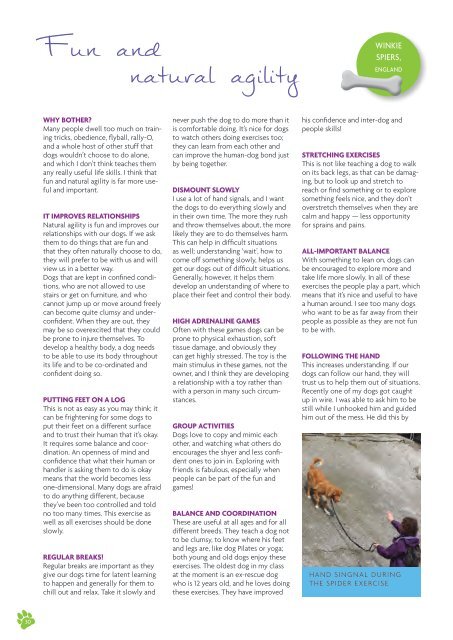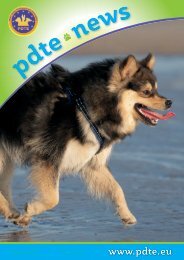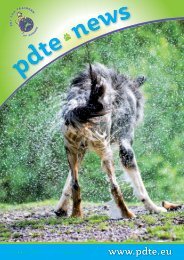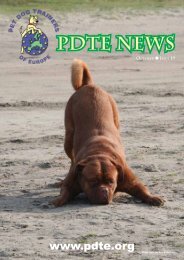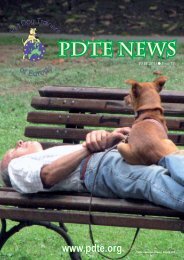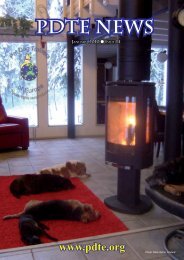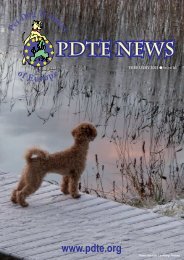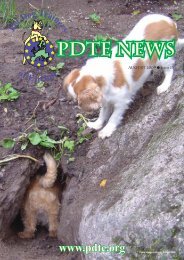PDTE 2013 Winter Newsletter
Create successful ePaper yourself
Turn your PDF publications into a flip-book with our unique Google optimized e-Paper software.
Fun and<br />
natural agility<br />
WINKIE<br />
SPIERS,<br />
ENGLAND<br />
WHY BOTHER?<br />
Many people dwell too much on training<br />
tricks, obedience, flyball, rally-O,<br />
and a whole host of other stuff that<br />
dogs wouldn’t choose to do alone,<br />
and which I don’t think teaches them<br />
any really useful life skills. I think that<br />
fun and natural agility is far more useful<br />
and important.<br />
IT IMPROVES RELATIONSHIPS<br />
Natural agility is fun and improves our<br />
relationships with our dogs. If we ask<br />
them to do things that are fun and<br />
that they often naturally choose to do,<br />
they will prefer to be with us and will<br />
view us in a better way.<br />
Dogs that are kept in confined conditions,<br />
who are not allowed to use<br />
stairs or get on furniture, and who<br />
cannot jump up or move around freely<br />
can become quite clumsy and underconfident.<br />
When they are out, they<br />
may be so overexcited that they could<br />
be prone to injure themselves. To<br />
develop a healthy body, a dog needs<br />
to be able to use its body throughout<br />
its life and to be co-ordinated and<br />
confident doing so.<br />
PUTTING FEET ON A LOG<br />
This is not as easy as you may think; it<br />
can be frightening for some dogs to<br />
put their feet on a different surface<br />
and to trust their human that it’s okay.<br />
It requires some balance and coordination.<br />
An openness of mind and<br />
confidence that what their human or<br />
handler is asking them to do is okay<br />
means that the world becomes less<br />
one-dimensional. Many dogs are afraid<br />
to do anything different, because<br />
they’ve been too controlled and told<br />
no too many times. This exercise as<br />
well as all exercises should be done<br />
slowly.<br />
REGULAR BREAKS!<br />
Regular breaks are important as they<br />
give our dogs time for latent learning<br />
to happen and generally for them to<br />
chill out and relax. Take it slowly and<br />
never push the dog to do more than it<br />
is comfortable doing. It’s nice for dogs<br />
to watch others doing exercises too;<br />
they can learn from each other and<br />
can improve the human-dog bond just<br />
by being together.<br />
DISMOUNT SLOWLY<br />
I use a lot of hand signals, and I want<br />
the dogs to do everything slowly and<br />
in their own time. The more they rush<br />
and throw themselves about, the more<br />
likely they are to do themselves harm.<br />
This can help in difficult situations<br />
as well; understanding ‘wait’, how to<br />
come off something slowly, helps us<br />
get our dogs out of difficult situations.<br />
Generally, however, it helps them<br />
develop an understanding of where to<br />
place their feet and control their body.<br />
HIGH ADRENALINE GAMES<br />
Often with these games dogs can be<br />
prone to physical exhaustion, soft<br />
tissue damage, and obviously they<br />
can get highly stressed. The toy is the<br />
main stimulus in these games, not the<br />
owner, and I think they are developing<br />
a relationship with a toy rather than<br />
with a person in many such circumstances.<br />
GROUP ACTIVITIES<br />
Dogs love to copy and mimic each<br />
other, and watching what others do<br />
encourages the shyer and less confident<br />
ones to join in. Exploring with<br />
friends is fabulous, especially when<br />
people can be part of the fun and<br />
games!<br />
BALANCE AND COORDINATION<br />
These are useful at all ages and for all<br />
different breeds. They teach a dog not<br />
to be clumsy, to know where his feet<br />
and legs are, like dog Pilates or yoga;<br />
both young and old dogs enjoy these<br />
exercises. The oldest dog in my class<br />
at the moment is an ex-rescue dog<br />
who is 12 years old, and he loves doing<br />
these exercises. They have improved<br />
his confidence and inter-dog and<br />
people skills!<br />
STRETCHING EXERCISES<br />
This is not like teaching a dog to walk<br />
on its back legs, as that can be damaging,<br />
but to look up and stretch to<br />
reach or find something or to explore<br />
something feels nice, and they don’t<br />
overstretch themselves when they are<br />
calm and happy — less opportunity<br />
for sprains and pains.<br />
ALL-IMPORTANT BALANCE<br />
With something to lean on, dogs can<br />
be encouraged to explore more and<br />
take life more slowly. In all of these<br />
exercises the people play a part, which<br />
means that it’s nice and useful to have<br />
a human around. I see too many dogs<br />
who want to be as far away from their<br />
people as possible as they are not fun<br />
to be with.<br />
FOLLOWING THE HAND<br />
This increases understanding. If our<br />
dogs can follow our hand, they will<br />
trust us to help them out of situations.<br />
Recently one of my dogs got caught<br />
up in wire. I was able to ask him to be<br />
still while I unhooked him and guided<br />
him out of the mess. He did this by<br />
HAND SINGNAL DURING<br />
THE SPIDER EXERCISE<br />
30


